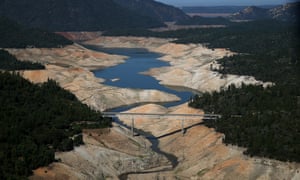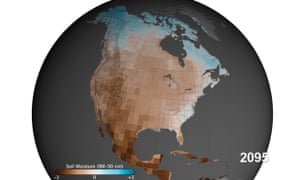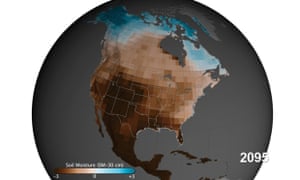NEWS
Ebb and Flow

Nasa climate study warns of unprecedented North American drought
We need to cut carbon pollution to avoid North American mega-droughts

California is in the midst of its worst drought in over 1,200 years, exacerbated by record hot temperatures. A new study led by Benjamin Cook at Nasa GISS examines how drought intensity in North America will change in a hotter world, and finds that things will only get worse.
Global warming intensifies drought in several ways. In increases evaporation from soil and reservoirs. In increases water demand. It makes precipitation fall more as rain and less as snow, which is problematic for regions like California that rely on snowpack melt to refill reservoirs throughout the year. It also makes the snowpack melt earlier in the year. The record heat has intensified the current California drought by about 36%, and the planet will only continue to get hotter.
The study finds that drought intensity will increase, but could be manageable if we follow a path that involves slowing global warming by cutting carbon pollution.

However, decades-long mega-droughts in North America could be much worse than those experienced during medieval times, which led to the decline of native populations, if we continue on our current business-as-usual path.

Jason Smerdon, a co-author and climate scientist at Columbia University’s Lamont-Doherty Earth Observatory, described the implications of the study in stark terms,
The 21st-century projections make the [previous] mega-droughts seem like quaint walks through the garden of Eden
The mega-droughts are projected to hit the main agricultural regions in the United States – both California and the Midwest “breadbasket.” The chronic water shortages that are anticipated in these regions under the business-as-usual scenario would make farming, as well as ranching in the American southwest, nearly impossible.
This study reveals the flaw that underlies the ‘CO2 is plant food’ myth. While some types of plants benefit from a high-CO2 environment in a greenhouse where we can control all other variables, in the global climate, carbon pollution has other consequences. Among these are higher temperatures and more intense droughts, which are not good for plants or agriculture.
It’s another example of the risks we face in a hotter world. This is an important time in human history, where we’re at a fork in the road. If we follow the business-as-usual path, we move towards a future with extremely disruptive climate consequences, like mega-droughts and water shortages in major agricultural regions. If we follow the path to cut carbon pollution, we significantly reduce the risks of disruptive climate change.
